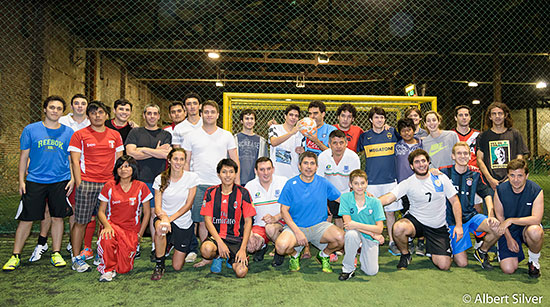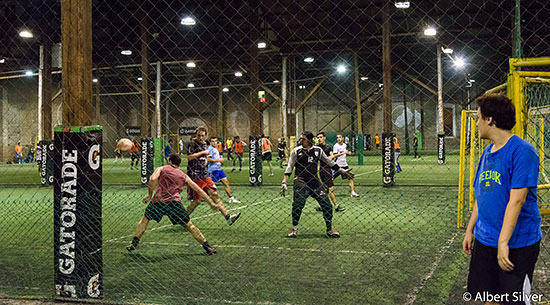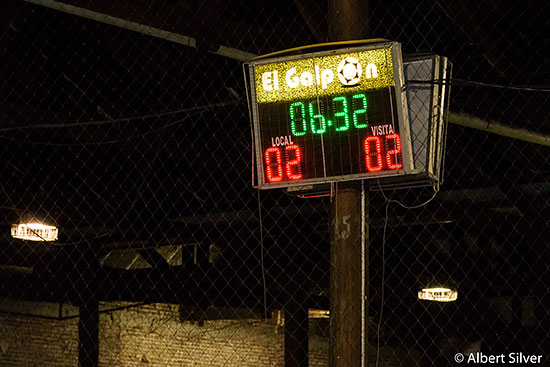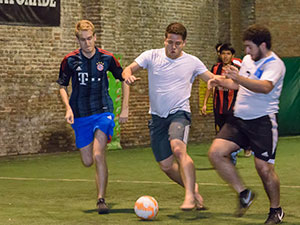
The tournament
The tournament is an eleven-round competition played at 40 moves in 90 minutes followed by 30 minutes for the rest of the game and a 30-second increment as of move one. The first round is on May 15 with rounds every day until round eleven on May 24, including a double-round on May 17. Play typically starts at 5PM.
Although there are tiebreak scoring systems in place, starting with direct encounter, Buchholz, and more, in the event of a draw at the top, the top four qualifiers will be decided by a rapid tiebreak match or tournament, depending on the number, starting at 15 minutes plus a ten-second increment.
The prizes are US$5000 for first, $3400 for second, $2400 for third with prizes all the way to 20th place. Note that as FIDE events of this caliber, all norms scored count double, thus a player who scores a norm at the end of the competition will be considered to have earned two norms, not one.
The players' football
On the day of the fourth round, all players found a small piece of paper at their board, inviting them to play in the late-night football match to be held after the fifth round, at 10 PM. If the organizers wanted to be certain everyone saw the invitation, to ensure the greatest number of participants, they succeeded.
Dozens of players turned up to partake in this great chess tradition: the player’s football match. Granted not all events do this, but when they do, football is the most common choice since it is certain to get the most to join up.

More players than expected turned up to play the late-night game (click image for high-res version)

A discussion on the division of teams. In the end, the players freely migrated since, even
with two full fields, there were too many players. (click image for high-res version)
From a photography point of view, I should add that this is by far the most challenging aspect of the tournament to cover. There are a number of reasons for this, most being technical, related to the poor lighting, and fast action. I will try to explain in simple terms.
Since the game is football, you will want to try to freeze the action as much as possible. In football that would ideally mean 1/500 of a second or faster. The problem is that each time you double the speed, you lose a full stop of light. In other words the image gets radically darker. In a birght sunny day, it is a non-issue, but in an indoor area with barely adequate fluorescent lighting it is a different matter. To compensate for this, you will need to raise the ISO, an electronic brightness enhancement, but the more you do this, the more noise invades the picture, and the more the colors suffer, making it less and less appealing. Finally, there is the camera's autofocus. Following such action in such low light leaves most cameras struggling to lock focus, so the lens goes back and forth when it fails. In the end, as you can guess, it is a balancing act.

In such a small field, the action was non-stop

There was barely any sideline so it meant having to jump out of the way when it came my way

Not all the players had cleats, so they decided to play in their bare feet

The Peruvians stayed together for the most part, though not always as Deysi Cori finds herself
the victim of a steal by her compatriot, while her brother Jorge Cori watches

Jorge Cori did more than watch of course, and enjoys his chance here for some action

Julio Granda Zuñiga (blue) is a well-known footbal nut, and very skilled player

Diego Flores from Argentina was one of the most skilled on the pitch. Still, it was not all about skill,
and all you needed was a willingness to run and have fun.

Argentinian IM Claudia Lujan was the best of the girls by far and a match for many of the male players

In spite of the late hour, the hangar where the eight (!) football fields (sized for five-player
teams) was jam packed with waiting lines even at 11PM. (click image for high-res version)

The clocks keeping score and time
Round six
The sixth round started with two clear leaders, both playing their best: young Peruvian Jorge Cori and Paraguayan GM Axel Bachmann. The two leaders were set to meet and a fight to the death.

GM Axel Bachmann came ready to battle

The competition has been as exciting as can be with exemplary fighting spirit from all
IM Luis Rodi described the game: "The fight between the leaders in the sixth round was a savage opening fight with pieces hanging all over the board. When the smoke had cleared, White held a clear advantage, which the talented Peruvian grandmaster Jorge Cori converted with superb technique."
GM Jorge Cori - GM Axel Bachmann (annotated by IM Luis Rodi)

[Event "Continental"] [Site "Montevideo"] [Date "2015.05.19"] [Round "6"] [White "Cori, Jorge"] [Black "Bachmann, Axel"] [Result "1-0"] [ECO "E04"] [WhiteElo "2609"] [BlackElo "2636"] [Annotator "Rodi,Luis"] [PlyCount "63"] [EventDate "2015.05.19"] [EventCountry "URU"] 1. d4 Nf6 2. g3 {A move order that was used by Savielly Tartakower in Barcelona 1929, which is what led it to be called the "Catalan Opening". In a few moves we will have the basic starting position of modern theory.} e6 3. Bg2 d5 4. c4 dxc4 5. Nf3 a6 6. Nc3 $5 {An unusual move for this piece in the Catalan, where the main lines start with 6.0-0, as recommended by Boris Avrukh in his book on the opening, and 6.Ne5. From the onset, the game is taking on an original character.} Nd5 $5 {Bachmann also contributes to the opening's complexity.} ({The usual reply is} 6... b5 {where} 7. Ne5 Ra7 8. a4 Bb7 9. Bxb7 Rxb7 10. axb5 axb5 11. O-O Bd6 $13 {is Wang Yue - Jianu, Bazna blitz 2014}) 7. Ne5 $146 {Thematic, but in this exact position constitutes a novelty.} ({The main line goes} 7. O-O {which after} b5 8. Ne5 Bb7 {can lead to wild scenarios after} 9. Nxd5 exd5 10. e4 {for example} dxe4 11. Qh5 g6 12. Nxg6 fxg6 13. Qe5+ Qe7 14. Qxh8 Nd7 15. h4 O-O-O 16. Bg5 Qf7 17. Bh3 Re8 18. Qf6 Qd5 $13 {Garcia Gonzalez - Sisniega, La Habana 1982}) 7... Bb4 8. O-O {The beginning of an interesting plan that involves saccing pawn and then piece.} ({Cori chooses to eschew the natural} 8. Bd2 Nb6 $11) 8... Nxc3 {The Paraguayan grandmaster accepts the challenge.} (8... O-O 9. Qc2 b5 10. Be4 {with a White initiative.}) 9. bxc3 Bxc3 10. Rb1 Qxd4 11. Qa4+ $1 b5 (11... Nd7 12. Bxb7 $14 {is a nice point of White's play.}) 12. Qa3 $1 Qxe5 13. Bf4 Qf6 14. Bxc7 Be5 (14... b4 15. Rxb4 $1 Bxb4 16. Qxb4 a5 $1 17. Qb5+ Bd7 18. Qb7 O-O 19. Qxa8 Nc6 20. Qb7 { with an initiative for the pawn.}) 15. Bxe5 Qxe5 16. Bxa8 {Time to do the balance. After many adventures, material is approximately equal (rook versus knight and two pawns). White is better developed while Black's king is still stuck in the center. These factors are more important in the position's evaluation than the black queenside majorty in my opinion, and promise White a lasting advantage.} f5 $6 {The start of serious issues for Black. Bachmann wants to do a castle "by hand", but I think his undeveloped pieces spoke louder here.} ({The computer recommends} 16... Qc7 {but here too Black has his work cut out for him.} 17. Bg2 h5 18. Rfd1 h4 19. Rd2 {with the initiative.}) 17. Rfd1 $14 {The tactical phase now opens way to the technical phase: White converts his advantage in excellent fashion.} Kf7 18. e4 (18. Rd6 $5 {to double the rooks was also strong.}) 18... Nd7 19. Bc6 Nf6 20. exf5 exf5 21. Qa5 $1 {Once Black had opened the way for his rook thanks to his king move, the white queen no longer had an reason to stay on a3.} Ne4 22. Bd5+ Kg6 (22... Ke7 23. Qb6 $18) (22... Be6 23. Bxe4 Qxe4 (23... fxe4 24. Qxa6 $16) 24. Qc7+ Kf6 25. Re1 $16) 23. Bxe4 Qxe4 $2 {Very risky} ({Better was} 23... fxe4 24. Qb6+ Kf7 25. a4 $14) 24. Rd6+ Kf7 25. Re1 $18 {With the white rooks dominating the central files and the black king without a safe haven, it is clear that Black has made things worse for himself.} Qb7 26. Qd2 Rf8 27. Qd4 h6 28. h4 Kg8 29. Rd8 {What follows is simple and Cori converts with good technique.} Qc6 30. Re7 Qf6 31. Qxf6 gxf6 32. Ree8 {A brilliant game by the young Peruvian.} 1-0
After the top battle left Cori alone at 5.5/6, a gorup of seven trail right behind with 5.0/6, led by American Aleksander Lenderman on tiebkreak, with Alexander Shabalov, Alan Pichot, and more.

GM Carlos Matamoros drew Julio Granda Zuñiga in round six

WFM Suzanna Chang is on 3.0/6 outperforming her rating

The main hall where the rest of the struggles take place

GM Sandro Mareco overcame IM Evandro Barbosa in round six, and was
promoted to the stage for round seven

IM Roberto Molina observes his opponent (Click on image for high-res version)
Standings after six rounds
Click for complete standings
The top eight boards of the event can be followed live at both the official site and on Playchess.
All photos by Albert Silver













































